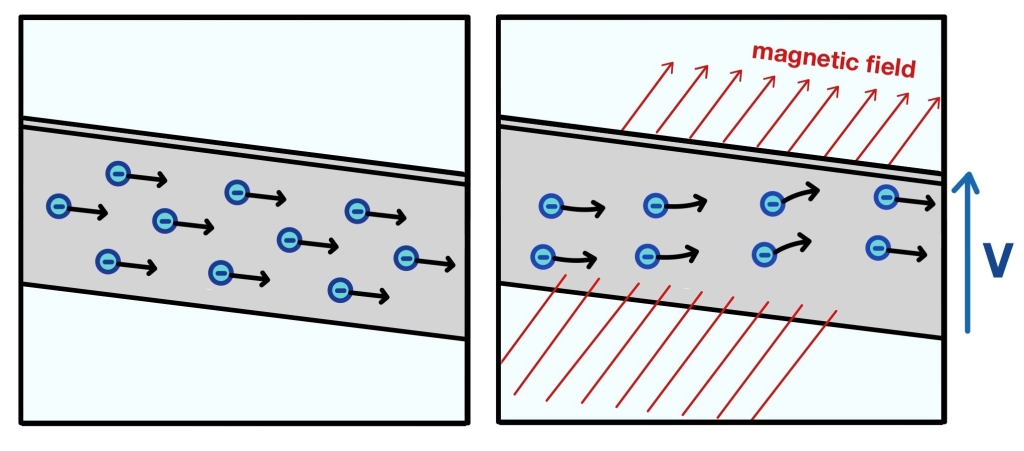Flexible and robust: the Hall sensor

The level measurement of your car, flip covers for smartphones and current clamps. These three things have one thing in common: They all use Hall sensors to reliably perform their function.
Hall sensors are sensors for detecting magnetic fields. But how do Hall sensors work and how can we explain the multitude of completely different applications? To answer these questions, we must first take a look at the physical Hall effect. The Hall effect is the theoretical and practical basis of every Hall sensor.
The Hall effect
If current is allowed to flow through an ordinary conductor, the charge carriers (of which the current is composed) move in a straight line through the material. This means that charge carriers, such as electrons, are not deflected from their straight-line path. This is the normal case, which we know from everyday life and school. It can be seen in the figure below.
However, this straight-line charge flow can be disturbed by applying a force to the charge carriers. But how to exert a force on each single electron? For this purpose, a magnetic field is used. Each moving charge carrier experiences a force in a magnetic field, which is perpendicular to its direction of motion and the acting magnetic field. This is the so-called Lorenz effect.
Thus, if a current is allowed to flow through a conductor and this conductor is placed in an external magnetic field, the charge carriers are deflected from their straight path. If the magnetic field points into the direction indicated by the red arrows below, the charges move upwards. However, since now the charges accumulate at the upper end of the conductor, an electric voltage occurs. This effect is called Hall effect: An electrical conductor in a magnetic field produces a voltage perpendicular to the direction of the current.

Principle of the Hall effect. Left: undisturbed current flow, right: current flow in magnetic field
Realization of the Hall sensor
As described above, the Hall effect only occurs when a current can flow. Therefore, it is obvious to use metallic conductor plates as Hall sensors. However, the Hall effect is even more pronounced in semiconductors. In practice, a Hall sensor therefore consists of a thin semiconductor layer.
At least four electrodes must be attached to the side of this semiconductor. Two of these electrodes are responsible for the current flow through the semiconductor, the other two contacts pick up the Hall voltage perpendicular to the current.
The Hall voltage that a silicon-based Hall sensor produces, is in most cases in the millivolt range and thus relatively small. In addition, semiconductors exhibit a noticeable temperature dependence, which can distort the measurement. To meet these circumstances, Hall sensors are usually available as complete integrated circuits (IC). In addition to the sensor, these IC also contain operational amplifiers and temperature compensations.
Wide range of applications
Magnetic fields are something that most people only know from their refrigerator magnets or compasses. But if you take a closer look, magnets do hide everywhere in our daily life. One can detect them by using Hall sensors.
Especially because of their immunity to (non-magnetic) dust, liquids and their very small size, Hall sensors are very popular. Especially the automotive industry has a lot of applications for Hall sensors:
- Your car’s seatbelt buckle uses Hall sensors to check whether you are wearing a seatbelt.
- The RPM measurement of your car is based on the Hall effect. With each revolution of the wheel, a magnet attached to it also moves past a Hall sensor.
- To determine the level of your tank, a magnet is allowed to float on the surface of the liquid. If the tank fills, the magnet approaches the Hall sensor mounted at the top, which provides a signal.
Flip covers for cell phones or tablets often contain magnets as well. When the flip cover closes, a Hall sensor in the device detects the magnet and activates the standby mode.
Current clamps offer another application. There, the Hall effect serves the purpose of measuring the magnetic field produced by the power cable. Thus, current clamps can be realized, which are also able to measure DC current. We have already described the functionality of current clamps more closely in this blogpost.
In addition, Hall sensors have applications in many other areas, for example as switches in electronic systems. A Hall sensor is also a convenient way to realize quite classic applications such as compasses or the measurement of spatial magnetic fields.
Your sensor – our measuring system
Are you looking for a manufacturer that adapts perfectly to your needs? Then DEWETRON is the right choice for you. DEWETRON is an Austrian manufacturer of high-precision and modular measuring systems, as well as the intuitive OXYGEN measurement software.
No matter which sensor you want to use, we provide you with the necessary equipment. For example, our TRION3-1810-SUB-8 measurement board offers you eight interchangeable submodule slots. You can occupy these with TRION submodules, which are available in a wide range of variations, whether you need a current or voltage input.
Our OXYGEN measurement software also enables you to handle sensors easily on the software side. The integrated sensor database proves to be practical in this respect. There you can store name, serial number, scaling information, filters of your sensors and much more. No matter which measurement setup you use next, your previously created sensor data is now ready for every use case.
Do you want to learn more about DEWETRON and our products? Then why not visit us on our DEWETRON website? There you will not only find more blogposts, but also a number of whitepapers, video tutorials and webinars. We are also regularly active on Twitter and LinkedIn.





